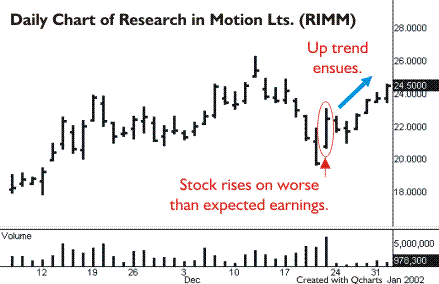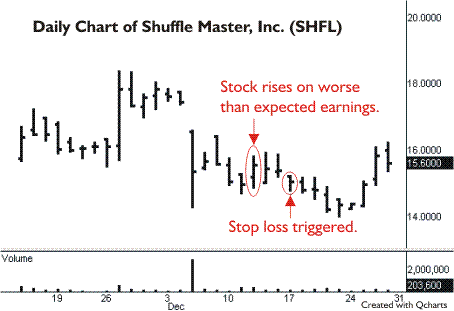How To Use TM’s Indicators: Stocks That Rose On Worse Than Expected Earnings
If good
news sends a stock down, what’s going to send it up? The focus of
this lesson is a little gem on TradingMarket’s “Stock
Indicators” page under “Actionable Signals & Other Indicators”:
Stocks That Rose On Worse Than Expected Earnings,
and
Stocks That Dropped On Better Than Expected Earnings.
Simply put, these alerts give setups with good risk/reward
characteristics.
Earnings are the underlying force of stock valuations, and nothing will change
the direction of a stock faster than earnings-related news. Surprises in
earnings reports almost never fail to make or break price action, and many
traders won’t even take a position in a stock the day of an earnings announcement
because it might drastically alter its trend. On the other hand, when alerted to
price action divergence from earnings news, the astute trader can take advantage
of certain situations.
A stock
that rises on worse than expected earnings, or falls on a better than expected
earnings, is telling you something is out of place. Whether it be institutional
interest or a less obvious agent, is not so much an issue as the fact
that the stock traded against the news. When analyzed in conjunction with
technical analysis, this divergence has the makings of a profitable setup
for a swing trade, or even a longer-term trend reversal.
When it
comes to interpreting market news for the sake of profiting, many of us have
experienced the madness that comes from illogical price swings, and seemingly
irrational behavior. As Larry Connors elucidates in
Street Smarts, we need to listen to what the markets are telling us. A
stock that rises on better than expected earnings is saying, “This may be bad
news, but I don’t care!” Just because it seems natural for a stock to rise on
good news in no way means that this will happen. The reverse is true
of a stock that falls on good news. The price action is what we should focus on.
Below
are four recent examples of stocks that acted counter to what their earnings
announcements suggested. As one might expect, these alerts can be few and far
between, and in keeping with reality, one of the examples illustrates a setup
that didn’t work out. Nothing is ever a sure thing in the markets, though
what we aim for is at least a good risk-to-reward ratio.
Example 1:
Research in Motion
(
RIMM |
Quote |
Chart |
News |
PowerRating)

In our first example, we have Research In Motion
(
RIMM |
Quote |
Chart |
News |
PowerRating) announcing earnings
of 8 cents a share, worse than analysts had expected. As you can see, the
stock didn’t seem to mind, and began an uptrend stemming from that news event.
Combining a little bit of bar chart analysis with this news could have
comfortably positioned a trader in this stock for a nice gain. The day the news
was released, a trend reversal in the daily bars set up, as the price action moved
higher than the previous two trading days ranges. If you were to have went long
the day after the report, at least a 2 point gain would have been made in six trading days.
A stop loss should have been placed above the high of the daily bar of the news
release.
Example 2: Shuffle Master
(
SHFL |
Quote |
Chart |
News |
PowerRating)
 H
H
Here is an example of an alert that didn’t work out. When Shuffle Master
announced earnings of 63 cents a share, worse than analysts had expected,
the stock initially rose. Unfortunately it did not make a trend reversal,
and a long position off the alert would have been a loser. The next two days of trading, despite some upward
momentum, produced tails on the daily bars, giving warning of some weakness in
the stock. If you were to have used a stop loss below the low of the day the
news event was triggered, you would have been out with minimal damage. Using technical analysis to aid in your decisions is definitely an advantage.
Some traders may have avoided the setup as the gap down was a sign of weakness,
though even the best of us put on losing trades. The intention of this
example is to educate.
Example 3: Apollo Group
(
APOL |
Quote |
Chart |
News |
PowerRating)

APOL announced earnings of 27 cents a share, beating
analysts’ expectations by a penny. The initial reaction to the news sent the
stock down. An astute trader may have taken the opportunity to short the
stock as its daily bars were also suggesting some downside momentum. Note the
ominous tail
leading into the news day’s expanded trend reversal bar. An short entry on the day after the news release
would have made at least 3 points
in nine trading days. A stop loss, placed just above the bar of
the news release day, would not have been triggered.
Example 4: Solectron
(
SLR |
Quote |
Chart |
News |
PowerRating)

SLR announced earnings of 8 cents a share, beating analysts expectations of 5 cents
a share. From looking at the chart, we can see the stock gapped down the day
before the news release, giving an indication of weakness. An entry on
the short side the day after the earnings report would have quickly turned into a
winner. A stop loss should have been placed above the high of the daily
bar of the news release. In this situation scaling out
of the position would be a great way to take some profits. For some great swing
trading and money management strategies take a look at
Dave Landry on Swing Trading.
Trading against the logic of a
news event is something many traders are uncomfortable with.
When analyzing news events, we need to keep in perspective “what is,” instead of
“what should be.” Getting caught in the emotions of news stories can often spell
trouble for traders, but with the right mind-set these events can be profitable.
The earnings alerts on TM’s “Indicators” page, should be viewed as invitations
from a stock to act counter-intuitively, and avoid some of the common pitfalls
that “the herd” mentality will get a trader in.
What seems like stepping in front of a train could
be your next ticket to a winning trade.
For The Best Trading
Books, Video Courses and Software To Improve Your Trading
